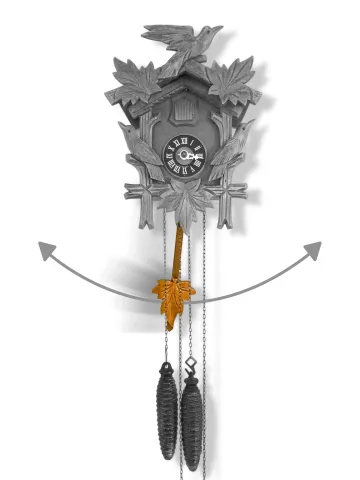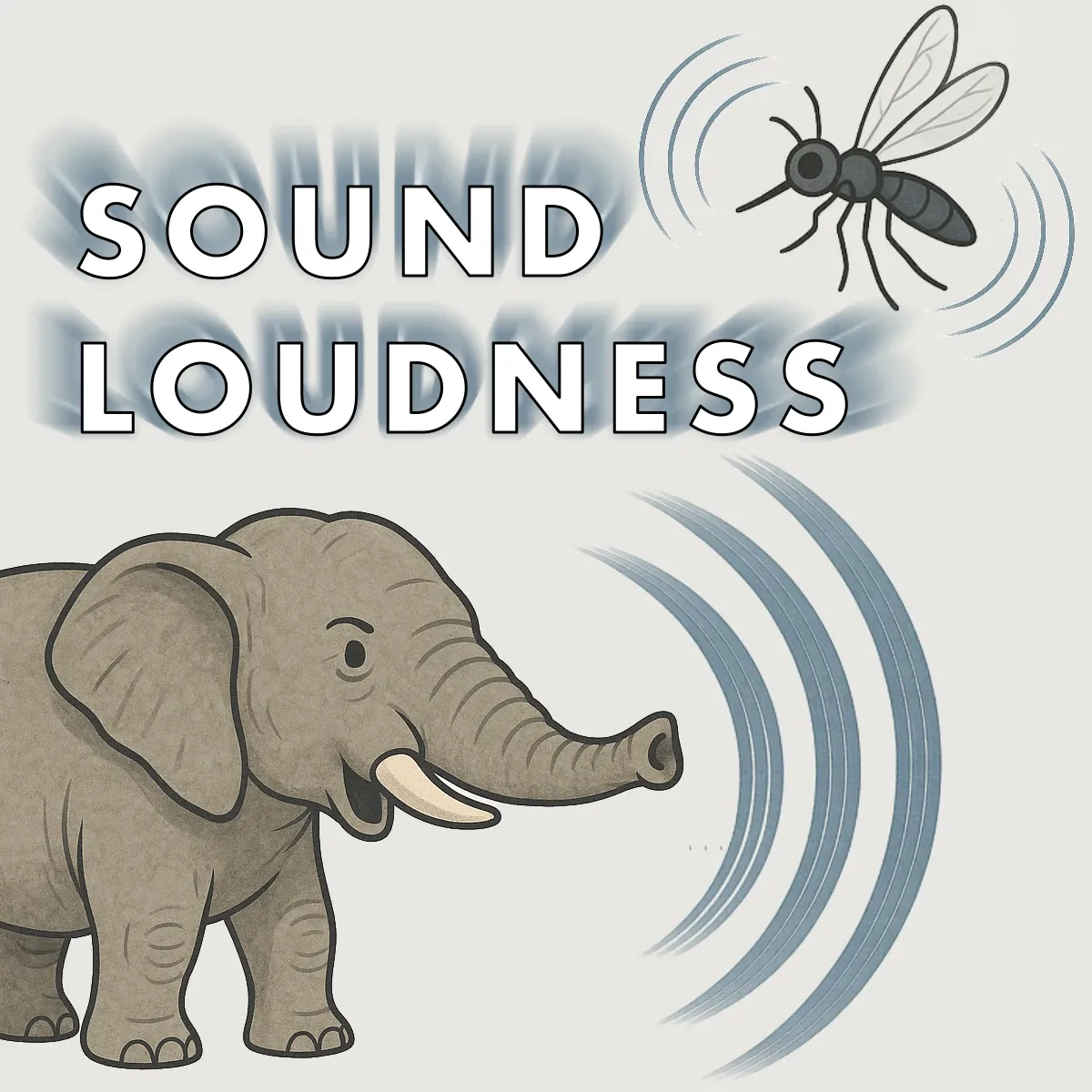Sound Loudness and How People Perceive It. What Does "Loud" and "Quiet" Mean?
Learn what sound loudness and amplitude are, whether loudness exists as a physical thing, how it is measured, and what decibels mean.
The Nature of Sound and How People Hear It

The even swinging of the pendulum back and forth in a wall clock
Sound is a physical phenomenon. It is made up of waves that travel through the air when something vibrates. When an object vibrates, it makes the air molecules around it move back and forth. These molecules push on their neighbors, passing the vibration along. You can think of this movement like a pendulum swinging back and forth. As a result, there are areas where the air is squeezed together (higher pressure) and areas where it is spread out (lower pressure). These changes create sound waves. Our ears pick up these sound waves and their physical properties. Then, our brain processes this information and turns it into what we experience as sound—something that can feel bright, colorful, or emotional. So, when we talk about loudness, it’s important to think not only about the physics but also about how people actually hear sounds. You can read more about what sound is and how we perceive sound in other articles.
Amplitude of Air Molecule Vibrations
Amplitude means how far air molecules move from their normal position when a sound wave passes by. The harder a musician hits a guitar string, the more energy goes into the string, the more it vibrates, and the farther it moves from its resting position.

The swing of a pendulum forward and backward depends on how strong the force was that started it moving
So, when you hit the string harder, the amplitude (the size of the vibration) is bigger than if you just touch it lightly. The string’s vibrations are passed to the air molecules. They start to move back and forth too, with about the same amplitude. The amplitude of these vibrations can be measured in millimeters, micrometers, or nanometers (which are very tiny units of length).
This movement of air creates different sound effects and phenomena.
Sound Pressure
When air molecules move back and forth, they create areas where the air is more crowded (higher density) and areas where it is less crowded (lower density). The crowded areas are called compressions (high pressure), and the less crowded areas are called rarefactions (low pressure). These changes in air density cause changes in pressure—this is what we call sound pressure. The bigger the amplitude of the vibrations, the higher the sound pressure, and vice versa. Sound pressure is directly related to how far the air molecules move. Sound pressure is measured in pascals. The range of sound pressure is huge, from 0.00002 (2 micropascals) up to 100 pascals.
Sound Intensity
When talking about sound pressure, people also mention sound intensity. This means how much power or energy a sound wave carries. The higher the sound pressure, the higher the intensity. Intensity is measured in watts per square meter (W/m2). This tells us how much energy passes through a certain area each second.
How Loudness Is Felt by People
Our ears sense how much the air is vibrating, or in other words, how far the air molecules move from their usual spot. Our brain turns this information into the feeling of loudness. The bigger the amplitude of the vibrations, the louder a sound seems to us. So, loudness is our personal feeling based on amplitude, sound pressure, and intensity. But loudness depends on more than just amplitude; other things matter too. From what we’ve said before: Loudness does not exist as a physical thing; it only exists in our minds.
Loudness is how a person feels the strength of air vibrations.
Measuring Sound Loudness
Can we measure loudness? Strictly speaking, we cannot measure it directly because loudness is a personal feeling, not a physical value. What we can do is measure sound pressure—the result of air vibrations—and then compare this measurement with how people say they feel about different sounds. As mentioned above, sound pressure values can be very large or very small. If we try to describe loudness using micropascals (the units used for measuring sound pressure), these numbers won’t mean much to most people. For example, 0.00002 pascal is the quietest sound a person can hear. Two pascals is as loud as someone speaking loudly. But what does a sound with 0.00525 pascals feel like? How does it compare to 1.00111 pascals? These numbers are hard for most people to understand or imagine.
Decibels

The sound volume at a rock concert reaches 120 dB
To connect measured sound pressure with how people hear loudness, we use a special unit called the decibel (dB). Pressure measured in pascals is converted to decibels using a special math formula. The decibel level shows how much greater the sound pressure is compared to the quietest sound we can hear (the hearing threshold). Without going deep into math or physics, decibels help us express how loud a sound feels to people based on measured sound pressure, but using numbers that are easier to understand. The decibel scale is not linear, which means an increase of just a few decibels can mean the sound is many times louder.
EXAMPLE: If the sound level goes from 60 to 70 dB, this means the intensity increases about 10 times—not just by 10%.
Maximum Loudness Levels
The quietest sound people can hear is 0 dB (zero decibels). This matches 0.00002 pascal of sound pressure. There can be sounds with less than 0.00002 pascal of pressure in nature, but our ears cannot detect them, so we cannot hear them. The highest safe loudness for people is about 120 dB. This matches 20 pascals of sound pressure. However, listening to this level for a long time can still damage your hearing.
Decibel A – Adjusted Sound Level
It’s not easy to judge loudness just by decibels or pascals. Decibels do not consider everything that affects how loud a sound feels to us. Today, people often use dBA (decibel A), which is an adjusted measurement that takes into account how our ears respond to different frequencies.
To get an idea of how loud something is, you can remember some common sounds and their typical decibel levels, and then compare these numbers with sounds you hear every day. In Table 1 below you will find examples of familiar sounds at different loudness levels and their approximate decibel values. If you want to measure sound level yourself, you can use a special device or download an app for your phone that measures sound.
Table 1. Everyday Sounds and Their Loudness in Decibels
| Decibels, dB(A) | Description | Example Sound Source |
|---|---|---|
| 0 | Hearing threshold | Silence, mosquito flying several meters away |
| 10-20 | Very quiet | Rustling leaves, quiet room, whisper |
| 20-30 | Quiet sound | Whisper nearby, ticking clock, breathing |
| 30-50 | Normal loudness | Office, city apartment, normal conversation, running fridge |
| 50-70 | Louder than average | Loud conversation, passing car |
| 70-90 | Very loud | Shouting, truck, freight train |
| 90-110 | Extremely loud | Construction site, nightclub music. Danger zone for long exposure. |
| 110-120 | Painfully loud | Helicopter takeoff, jackhammer nearby, rock concert |
| 130-140 | Pain threshold | Airplane takeoff nearby, gunshot |
| Over 140 | Concussion/injury risk | Rocket launch, gunshot close by, volcano eruption |
Conclusion
Loudness is not just a physical value—it’s the result of a complex interaction between sound vibrations and our own perception. Although it is related to things like amplitude, sound pressure, and intensity, in the end it’s our brain that decides if something seems loud or quiet to us. Understanding this connection between physics and feelings helps us better appreciate what sound really is, and reminds us to be aware of the sounds around us—whether it’s street noise, a friend’s whisper, or music in headphones.
Information sources
- Technical Manual on the Impact of Noise on Humans, U.S. Federal Labor Agency
- App for determining sound level, National Institute for Occupational Safety and Health, USA
- The book "Sound: Listening, Hearing, Observing" by Michel Chion
Author team instrumental-music.eu
Last updated:

What is sound volume and can it be measured